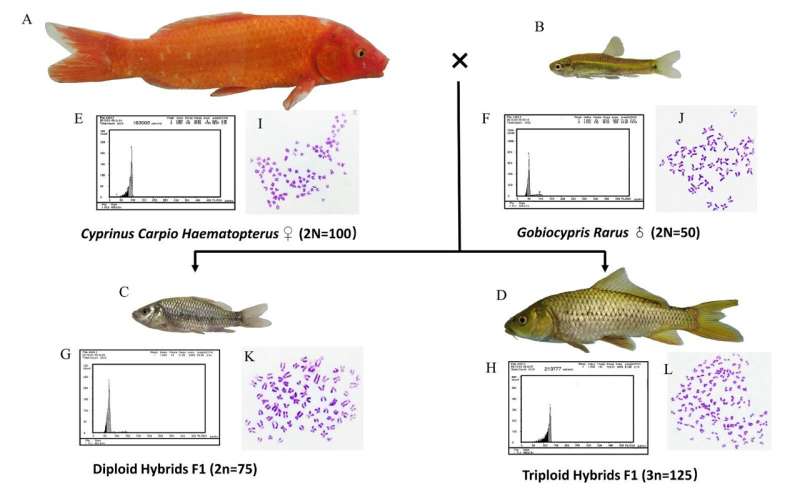This article has been reviewed according to Science X's editorial process and policies. Editors have highlighted the following attributes while ensuring the content's credibility:
fact-checked
proofread
Comparison of diploid and triploid hybrid fish from the same parents

The determination of animal growth rate and body size is an interesting scientific issue, and understanding the molecular mechanisms involved can guide agricultural production for genetic breeding. However, differences in the genetic background across species have led to slow progress in related research.
In a study published in Reproduction and Breeding, a team of researchers from China produced new germplasm resources through distant hybridization to explore the determination of growth rate and body size in fish.
Distant hybridization refers to crosses between two different species, genera, or higher taxa. The production of hybrid progeny is important for the enrichment of germplasm resources. In the study, Koi carp and Chinese rare minnow were selected as parents for the hybridization experiment. These two parent species belong to different subfamilies within the Cyprinidae family and showed significant differences in growth rate, body size, reproductive cycle, and spawning behavior.
"The hybrid offspring can combine the biological characteristics and genome of both parents, which enables the matching of phenotypes and genotypes," explains co-corresponding author Yuqin Shu, a researcher at the State Key Laboratory of Developmental Biology of Freshwater Fish at Hunan Normal University.
The obtained progenies were classified as allodiploid and allotriploid based on their DNA content, chromosome numbers. The comparison between the two kinds of hybrid progenies and their parents on countable traits, measurable traits, erythrocyte morphology, karyogene composition and mitochondrial gene composition demonstrates the appearances of the hybrids were between the parents.
"We also found the triploid hybrids showed faster growth rate and larger body size than the diploid hybrids under the same conditions," adds Shu. "The two kinds of hybrid offspring showing similar genetic background but distinct growth rate making them ideal subjects for investigations into growth traits."
The expression of growth-related genes was analyzed to investigate the reason for the difference in growth rate between the diploid and triploid hybrids. The researchers found that the growth-promoting genes, such as gh1 and igf1, were highly expressed in the triploid hybrids, while the opposite was true for the suppressor genes. These results partly explain the faster growth of triploid hybrids.
"A crucial aspect of our future research will involve an in-depth analysis of the underlying mechanism governing the gene expression patterns in diploid and triploid hybrids," says Shu.
More information: Min Wang et al, Characterization of allodiploid and allotriploid fish derived from hybridization between Cyprinus carpio haematopterus (♀) and Gobiocypris rarus (♂), Reproduction and Breeding (2024). DOI: 10.1016/j.repbre.2023.12.005
Provided by KeAi Communications Co.





















